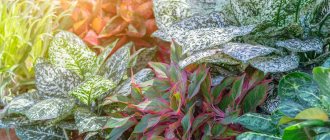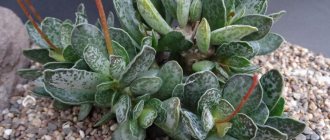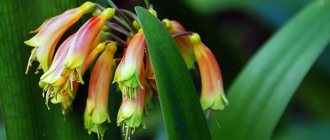Pachyphytum is a beautiful and unusual flower. Its small size looks good in an indoor flower garden or as part of a flower arrangement. This drought-resistant plant requires almost no attention and is easy to care for. Only a few species are bred at home, the most popular of which is Pachyphytum oviferum. It attracts with its unusual colors and compact rosettes.
Briefly about care
| Type of agricultural operation for pachyphytum care | Description of conditions and actions |
| Watering and air humidity | Water only when the soil dries out by a third in summer and almost completely in winter; humidity is dangerous for pachyphytum: rot can develop on the leaves |
| Lighting organization | Lighting prefers bright, but diffused |
| Maintaining a rest period | From early autumn to February - March; you need to reduce the frequency of watering and temperature |
| Creating temperature conditions | During the development period it should be 20-26 °C, and in winter - 12-16 °C; if the temperature drops to – 10 °C, the plant will freeze |
| Trimming | If necessary, to give a neat look |
| Making soil mixture | The soil needs to be loose and depleted in nutrients (it is good to use a mixture of soil for cacti and succulents with sand and perlite) |
| Fertilizer application | Fertilize pachyphytum 3–4 times during the period of active growth; use either potassium-phosphorus fertilizers or fertilizer for succulents and cacti (the dosage should be twice as weak as recommended) |
| Transfer | Pachyphytum needs to be replanted once every 2 years into a slightly larger flat container. |
| Chemical treatment | Insecticides: mealybug; fungicides: rot |
Useful video
The video contains a story about caring for this succulent:
The variety of colors and shapes of pachyphytum will allow you to create an interesting plant collection. The unusual decorative qualities of the succulent and its miniature size help the flower occupy its niche in the interior design of an apartment. And its unpretentiousness makes pachyphytum a favorite of gardeners.
READ ABOUT OTHER SUCCULENTS: GASTERIA, COTYLEDON, RASPAGE, LITHOPS, REPUBLIC, SEDUM, PORTULACARIA, SEDEVERIA, STAPELIA, HAWORTIA, AEONIUM, ECHEVERIA.
Description of the plant
Pachyphytum oviferum is a perennial plant from the Pachyphytum genus of the Crassulaceae family. In nature, this genus grows in Mexico and the southern states of the USA. All its plants are characterized by thick, fleshy leaves that store water, which is why they got their name.
In the photo, egg-bearing pachyphytum (P. oviferum)
The main difference between the egg-bearing variety is the appearance and color of the leaf. Its shape looks like a bizarre oval or a slightly flattened egg. Also, the top of the leaf blade is rounded, without a clear tip. The crown is gray in color, with a whitish coating on the surface. Because of its color and appearance, the plant was nicknamed “moonstone”.
Reference! There is pachyphytum oviferum rubra (P. oviferum rubra): this variety has almost completely pink leaves, only the stem has a lighter edge.
The plant has a compact appearance: the leaves are quite dense, and the stems themselves are no longer than 20 cm. The underground system consists of thin, highly branched roots.
The leaves are voluminous, they usually reach 1.5–2 cm in thickness, and are large enough for a succulent: up to 5 cm in length and 3 cm in width. They are arranged in a spiral pattern on the stem.
Arrangement of pachyphytum leaves
The shoots are initially erect and then drooping. With age, they stretch out and become bare below: old leaves dry out and fall off, leaving behind a scar on the stem. On top there is a rather dense socket. The stems often branch, forming lateral shoots.
Possible problems
Pachyphytum, thanks to its dense skin and waxy coating on the leaves, rarely suffers from pest invasion. It can be damaged by excessive watering and the use of cold water. In this case, root rot develops. It is manifested by withering of leaves, their wrinkling, and softening of the stem. It is difficult to save the plant at this stage; it is better to separate healthy leaves from it and plant the succulent.
How to identify root and stem rot in succulents and save the plants
When exposed to direct sunlight, pachyphytum can get burns - whitish spots on the leaves.
With insufficient lighting, the leaves of the succulent become smaller and lose their bright color.
Bloom
It blooms in July - September, throwing out a single peduncle in long arrows. A spike-shaped inflorescence with small drooping flowers is formed on it. They have 5 pale green petals with bright specks inside. Flowering is accompanied by a pleasant aroma.
Pachyphytum flowering
After flowering, seed pods in the form of small pods begin to form on the pachyphytum. But the seeds ripen only under natural conditions: with home breeding it is impossible to obtain high-quality planting material. It is better to cut off the inflorescence after the flowers have withered, thus stimulating the development of side shoots.
What you should know before purchasing Pachyphytum oviferum
| Mature plant size | The stem reaches 20 cm and a width of 1 cm |
| Lifespan | More than 10 years |
| Bloom | Blooms once a year |
| Aroma | Delicate sweet aroma |
| Safety | Not poisonous, but should not be eaten |
| Difficulty of care | Unpretentious plant |
| Uniqueness | Common type |
| Where can I buy |
general information
The plant belongs to the Crassulaceae family . Its name translated from Latin means “thick sheet”. The species includes about 12 varieties, but only a few of them are suitable for indoor keeping.
Motherland
The succulent originates from arid Mexico and is also often found in the southern United States.
Flowering time
The plant produces flowers after a dormant period , mainly in spring.
Growing a flower at home
Caring for pachyphytum at home is not difficult, but the culture requires certain conditions. The main danger when growing is excess moisture in the soil, which causes the flower to begin to rot.
The plant practically does not need support or pruning. Under optimal conditions, stem elongation is observed in old succulents. And it is better to rejuvenate such plants: cut off the upper part of the shoot and root it.
Attention! All manipulations with the bush (transplantation, planting, pruning, etc.) must be carried out carefully, if possible without touching the leaves. You can easily tear them off, or damage the velvety coating, which will lead to a deterioration in appearance.
Location and environment
Pachyphytum loves light, but it needs to be protected from direct aggressive rays: they will leave burns. Therefore, it is better to place the flower on a western or eastern window. In the north, the succulent will not have enough lighting, its leaves will turn pale, and it will stretch out too much. And on the south side the plant will have to be shaded during the day.
Reference! With sufficient lighting, the crown of the flower acquires a more saturated color. And the sockets themselves look denser and more compact.
Pachyphytum prefers dry and fresh air: the room needs to be ventilated periodically, and in summer the flower can be taken out into the garden or onto an open balcony. But there is no need to spray and wipe it. These procedures will damage the wax coating, which will cause “bald spots” to appear and the foliage will lose its decorative appearance. If drops of water remain on the leaves, dark spots may form there over time.
A comfortable temperature for the growth of pachyphytum is in the range from 20ᵒ C to 26ᵒ C. It tolerates higher degrees well, but the succulent needs to be provided with regular ventilation, or moved to an open space protected from rain.
The dormant period occurs in winter. At this time, the succulent rests at a temperature range of 12-16 ᵒC. If the room is warmer, the plant will come out of “hibernation,” and if the temperature drops to 10 ᵒC and below, the plant will freeze. Watering during the dormant period should be reduced so that the lump of earth has time to dry out, but it should not be overdried - the leaves will wrinkle.
Important! For flowering, a cool dormant period is important, as well as good lighting when emerging from it: from March to May.
Another important factor in plant development is soil. It must be loose so that the roots of pachyphytum can grow well in it. It should also pass water well and have weak or neutral acidity. It is best to use a substrate for succulents and cacti, diluted with coarse sand and perlite or fine gravel in a 3:1:1 ratio. You can take regular soil, but you need to dilute it with baking powder more strongly. It is better not to use peat and humus at all, since depleted soil is needed.
Illumination
Pachyphytum is photophilous, but in the south it will have to be protected from the burning sun. The ideal choice is a window in the east or west; if the window faces north, you will have to add additional lighting, otherwise the leaves will lose color, and you may not even get flower stalks. In summer, pachyphytum likes to relax in the country house or in the garden; the best option is to place it in the partial shade of trees.
Read here Croton: tips for caring and growing at home. Reproduction, transplantation and maintenance features (145 photos and videos)
Other varieties of pachyphytum: photos and names
A little more than 20 varieties of pachyphytum have been found in nature. And only a few of them are popular among gardeners:
bract
Pachyphytum bracteosum (P. bracteosum) - characterized by larger leaves and stems. The leaf blade is more elongated and flattened. The succulent grows up to 30 cm. The flowers are red.
Pachyphytum bracteosum
Compactum
Pachyphytum compactum (P. compactum) is a low representative, up to only 10 cm high. The stem is not exposed, and the leaves are medium-sized, cylindrical: only 1 cm wide and up to 4 cm long. The foliage is dark green with whitish streaks. The peduncle is very long, the flowers are red-orange.
Pachyphytum compactum
Lilac
Pachyphytum lilac or Amethystinum (Pachyphytum amethystinum) - similar in appearance to the ovoid variety of pachyphytum (photo below), but differs in smaller size. The leaves are spherical, about 1 cm in diameter, pink in color.
Pachyphytum lilac (P. amethystinum)
Glutinikaule
Pachyphytum glutinicaule (P. Glutinicaule) - similar to the compact form of a bract: a short stem and oval-shaped leaves. The plates are gray with a slightly pink top, covered with a whitish coating. The flowers are pink.
Pachyphytum glutinicaule
Baby finger
Also recently, the Pachyphytum Machucae variety has become popular; it is more often called Pachyphytum baby finger (P. baby finger). This is a compact pachyphytum with small leaves that look like children's fingers: they are shaped like a pointed grape. The color of the crown is light blue with a pink tint at the tips of the leaves, and is covered with a waxy coating.
Pachyphytum baby finger
Pachyphytum is a beautiful and unpretentious flower. Among most succulent plants, it stands out for its unusual appearance and pleasant aroma when flowering. Pachyphytum looks good both as a single plant and as part of a garden or florarium with succulents. It is so unpretentious in home care that even a beginner can handle it.
Soil composition
Succulents require poor, loose soil with the addition of pebbles, coarse sand or broken bricks. The soil reaction is neutral or slightly acidic. You can use a ready-made purchased soil mixture for succulents (if you have a choice, then for leafy ones).
You can prepare the soil yourself: take 1 part of leaf and turf soil and 1 part of coarse sand, fine gravel, crushed brick. You can add expanded clay, perlite, vermiculite.
Soddy soil can be replaced with humus, in which case the proportion of humus should be reduced (this is a very nutritious substance, and the soil needs to be depleted).











